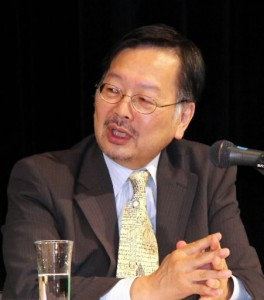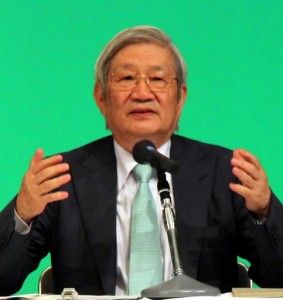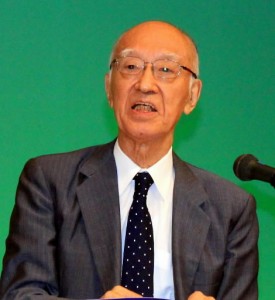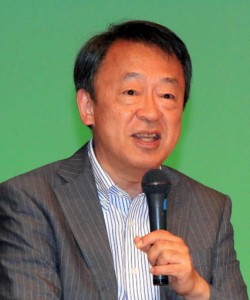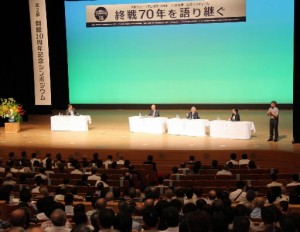Symposium reflects on 70 years since end of World War II, marks 10th anniversary of opening of Yamato Museum
Sep. 25, 2015
A symposium to commemorate the 10th anniversary of the opening of the Yamato Museum, which is located in the city of Kure, was held on August 29 at the Kure Culture Hall. The panelists exchanged views on Japan-U.S. relations during the Russo-Japanese War and during and after World War II, and discussed the philosophy of engaging in naval warfare with large ships, which led to the building of a number of huge battleships, including the battleship Yamato. The panelists were Kazushige Todaka, the director of the Yamato Museum; Kazutoshi Hando, a writer and honorary director of the museum; and Makoto Iokibe, the chairperson of the board of directors of the Prefectural University of Kumamoto. Akira Ikegami, a professor at Tokyo Institute of Technology, served as the moderator of the symposium, which was sponsored by a foundation for supporting local government and the event’s executive committee. The symposium attracted an audience of about 1,600.
Ikegami: Seventy years have passed since the end of World War II, and some young people are unaware that August 15 is the anniversary of the day the war ended. At the start of the Russo-Japanese War, relations between Japan and the United States were not bad. But the two nations began viewing one another as enemies and plunged into war. What were the points of contention?
Hando: Since the Meiji Era (1868-1912), Japan was sending students to the U.S. to learn the advanced technologies there. There was trust between the two countries. With regard to the Russo-Japanese War, Japan had planned for the end of that war before it started. It counted on the war ending through the mediation of the U.S. But Japan had no idea how to end the Pacific War. It planned only how to start the war.
Japan’s overwhelming victory in the Russo-Japanese War is what strained Japan-U.S. relations. The Japanese Navy destroyed the Russian Baltic Fleet, a feat that surprised the world. Japan intended to build on this victory by becoming a global power and set the national goal of creating a strong navy. But Japan lacked resources and power as a nation. The U.S. was troubled when, after that war, Japan acquired more interests in Manchuria.
Japan viewed the U.S. as a hypothetical enemy as it made military preparations. The Washington Naval Treaty, which put limits on the construction of battleships, was beneficial to Japan, since the country was in financial straits. But the Japanese Navy viewed the treaty as a ploy by the U.S. and began to regard the country as a real enemy. The U.S. was also pursuing measures to prepare for war against Japan. When the Showa Era (1926-1989) began, both nations were taking a more hostile view of each other.
Ikegami: Why didn’t Japan have a plan for ending the Pacific War?
Hando: Japan assumed that Germany would win. When the war broke out, it hadn’t thought through a method for ending the war on its own. Some people may take offense, but I have to say that the Pacific War was a reckless act.
Ikegami: While the Washington Naval Treaty set limits on the construction of battleships, Japan went ahead and built the battleships Yamato, Musashi and Shinano. What gave rise to the belief that large ships and superior firepower would bring victory?
Todaka: The “big-ship, big-gun” philosophy was a key part of prewar naval tactics. Prior to that, this idea didn’t exist. Up until the time of the Sino-Japanese War, battleships would sink the enemy’s battleships by ramming into them. This was a time the navy was developing its tactics through trial and error. The turning point was the Battle of Tsushima during the Russo-Japanese War. The world realized that enemy ships can be sunk from a certain distance with the use of cannons, wreaking catastrophic damage to the enemy.
Japan saw the U.S. as a hypothetical enemy, and the U.S. had much stronger economic might and big industries. Japan could never hope to outnumber the fleet of U.S. battleships, so it had to have a few but invincible battleships. Because the U.S. faces both the Pacific and the Atlantic, they built a needed number of battleships that could sail through the Panama Canal. Japanese engineers tried to respond to the unreasonable demand for unsinkable battleships and constructed the battleship Yamato.
Ikegami: What strategies did the U.S. have for dealing with Japan after the start of the Pacific War?
Iokibe: Before Japan and the U.S. went to war with one other, there were three stages in their relations. Before the Russo-Japanese War, the two countries had amicable relations with the U.S. acting as a mentor while Japan sought to modernize the nation. After that war, the U.S. began to worry about the Japanese Navy making inroads into the Philippines, and the U.S. developed mixed feelings toward Japan. “Harmony” and “antagonism” began to coexist in Japan-U.S. relations. Beyond the 1930s, relations soured into confrontation. Following the Manchurian Incident, the U.S. adopted a policy of non-recognition toward Japan. The U.S. did not intervene militarily, though it did not accept Japan’s actions. But Japan took the U.S. response lightly; it rushed ahead, completely unconcerned.
Japan insisted that the U.S. acknowledge the reality created by new powers in the world. At the same time, the U.S. would not accept Japan’s unilateral rule by force. Both of them stuck to their own principles, but neither wanted war. Before the U.S. delivered the Hull note (the Outline of Proposed Basis for Agreement between the United States and Japan), opinions were divided, with some arguing that the U.S. should take advantage of its improved productivity and wage war while others contended that at least three months could be gained by pursuing an interim agreement. Japan, too, had concluded that it could not defeat the U.S. But the final proposals made in the Hull note left no room for compromise. If the December 8 attack on Pearl Harbor [December 7 in the U.S.] had been delayed, Japan would not have become embroiled in the world war and lost. Four days before Pearl Harbor, Germany suffered a defeat in Moscow and was nearing its own end.
Ikegami: How did U.S. policy toward Japan lead to its postwar occupation policy?
Iokibe: The U.S. had two different scenarios for the occupation of Japan. Calling on Japan to surrender unconditionally was backed by the American public, but the idea of annihilating Japan with its military strength or exterminating an ethnic group was not supported, even within the administration. The other idea was to make Japan a peaceful and democratic nation and reintegrate it into the international community. As they worked to democratize Japan during the occupation period, those knowledgeable about Japan stressed that the emperor still held wide sway and was a person of proven worth, and they also sought to maintain the Japanese bureaucracy.
Why did the U.S. have Japan accept the conditions of the Potsdam Declaration instead of destroying the country completely? Japan fought with a do-or-die spirit on the islands of Iwo Jima and Okinawa, where there was a heavy loss of life on the U.S. side, too. If the U.S. had pursued Japan’s unconditional surrender and continued fighting these bloody battles, more young Americans would have shed blood. Many in Japan argued for all-out resistance, but the country eventually accepted the conditions of surrender under the emperor’s sacred decision. Japan and the U.S. were once engaged in mortal combat, but they have maintained a cordial relationship with one another over the past 70 years.
Ikegami: Understanding your opponent is very important. The U.S. considered Japan closely and carried out the occupation policy well. How did Japan intend to end the war?
Hando: In those days, Japan thought that unconditional surrender was the only possible way to end the war. The Battle of Okinawa began in April 1945 and similar battles on the mainland seemed inevitable. The cabinet of Kantaro Suzuki was launched at that time. Suzuki, who was a former grand chamberlain and had a trusting relationship with the emperor, was charged with bringing the war to an end. But there was the danger that the military could stage a coup. In those days it was the royal prerogative to start and end a war, and the cabinet approved and passed a policy that was agreed upon. Suzuki came up with the idea of requesting that the emperor issue the order to end the war, at risk to his own life, and have this order be accepted by the cabinet to make it national policy.
The military conspired to stage a coup. Their plan was to abduct those cabinet members who backed making peace during the cabinet meeting prior to the council held in the presence of the emperor. Sensing a threat, Suzuki made arrangements to hold the meeting with Emperor Showa at the Imperial Palace on August 14. Even military officials were unable to enter the palace. That was Suzuki’s last feat. After the emperor stated that he supported the idea of making peace, the imperial decision was immediately approved by the cabinet as national policy. Thus, the effort to end the war was barely achieved. One lesson from this is that waging a war is easy, but ending it can be very hard.
Ikegami: Why did the battleship Yamato undertake its last suicidal mission?
Todaka: There was mounting criticism over the fact that Japan’s most powerful battleship was remaining idle. It was plain that its suicidal mission was meaningless, but the navy had to show that it was putting forth its final effort. As expected, Yamato was sunk before it reached Okinawa. This was April 7, the day the Suzuki cabinet was formed. The sinking of Yamato was one of the forces driving Japan toward ending the war.
Ikegami: Japan-U.S. relations became better after the war.
Iokibe: Heavy casualties were inflicted, and there was deep hostility against Japan. But only a small number of people were responsible for making the policy for Japan’s occupation. The idea was to have people who knew Japan well craft this policy, and those who were sharply critical of Japan were not chosen for the task.
Ikegami: What do you think young people should learn and do?
Hando: The 70 years since the end of the war can be considered 70 years since the founding of a new nation. In this time, Japan has maintained an exclusively defense-oriented policy based on Article 9 of the Constitution and has earned the trust of the world. I hope young people will stretch these 70 years into 80 years, 90 years, and many more.
Iokibe: Generally speaking, a postwar period lasts 10 years. Shortly after the end of World War II, the Cold War era began between the U.S. and the Soviet Union. Japan had to cope with the Cold War while working toward a postwar recovery. When the Cold War ended in 1990, Japan went back to square one. In the aftermath of the Cold War, ethnic and religious conflicts broke out for the next 20 years. Again, Japan had to reenter a postwar period. I place my hopes on young people to revive Japan, which lost two decades.
Todaka: Not many people have direct knowledge of World War II, and that war will no longer be conveyed as experiences, but as history. In this 70th year since the end of the war, we must begin learning about it as history. The role of our museum will grow in importance.
Profiles
Kazushige Todaka
Born in Miyagi Prefecture in 1948. Graduated from Tama Art University. Became a member of the board of directors at a foundation for research on historical materials in 1992 and director of information on books at the National Showa Memorial Museum in 1999. Became deputy director of the planning division of the Kure municipal government in 2004. Took his present post in 2005. Has written books on the battleship Yamato, including Senkan Yamato Fukugen Project (Battleship Yamato Rebuilding Project) and Senkan Yamato ni Sasagu (Dedicated to Battleship Yamato).
Makoto Iokibe
Born in Hyogo Prefecture in 1943. Took posts as assistant, lecturer, and associate professor specializing in political and diplomatic history at Hiroshima University. Also served as visiting scholar at Harvard University and professor at Kobe University. President of the National Defense Academy of Japan between 2006 and 2012. Assumed his present position in 2012. Person of Cultural Merit.
Kazutoshi Hando
Born in Tokyo in 1930. Graduated from the faculty of letters of the University of Tokyo. Worked for Bungeishunju, a publishing company. Became a writer after serving as the editor in chief of the weekly magazine Shukan Bunshun (Weekly Bunshun). Won the Jiro Nitta literary award with Soseki zona moshi, a book on Natsume Soseki’s episodes. His other works include Nihon no Ichiban Nagai Hi (Japan’s Longest Day), Nomonhan no Natsu (The Summer in Nomonhan), and Isoroku Yamamoto.
Akira Ikegami
Born in Nagano Prefecture in 1950. Joined Japan Broadcasting Corporation, Japan’s public broadcaster, in 1973. Popular as a newscaster for Shukan Kodomo News (Weekly Children’s News) between 1994 and 2005. Became a freelance journalist in 2005. Took his current post in 2012.
(Originally published on September 5, 2015)
Ikegami: Seventy years have passed since the end of World War II, and some young people are unaware that August 15 is the anniversary of the day the war ended. At the start of the Russo-Japanese War, relations between Japan and the United States were not bad. But the two nations began viewing one another as enemies and plunged into war. What were the points of contention?
Hando: Since the Meiji Era (1868-1912), Japan was sending students to the U.S. to learn the advanced technologies there. There was trust between the two countries. With regard to the Russo-Japanese War, Japan had planned for the end of that war before it started. It counted on the war ending through the mediation of the U.S. But Japan had no idea how to end the Pacific War. It planned only how to start the war.
Japan’s overwhelming victory in the Russo-Japanese War is what strained Japan-U.S. relations. The Japanese Navy destroyed the Russian Baltic Fleet, a feat that surprised the world. Japan intended to build on this victory by becoming a global power and set the national goal of creating a strong navy. But Japan lacked resources and power as a nation. The U.S. was troubled when, after that war, Japan acquired more interests in Manchuria.
Japan viewed the U.S. as a hypothetical enemy as it made military preparations. The Washington Naval Treaty, which put limits on the construction of battleships, was beneficial to Japan, since the country was in financial straits. But the Japanese Navy viewed the treaty as a ploy by the U.S. and began to regard the country as a real enemy. The U.S. was also pursuing measures to prepare for war against Japan. When the Showa Era (1926-1989) began, both nations were taking a more hostile view of each other.
Ikegami: Why didn’t Japan have a plan for ending the Pacific War?
Hando: Japan assumed that Germany would win. When the war broke out, it hadn’t thought through a method for ending the war on its own. Some people may take offense, but I have to say that the Pacific War was a reckless act.
Ikegami: While the Washington Naval Treaty set limits on the construction of battleships, Japan went ahead and built the battleships Yamato, Musashi and Shinano. What gave rise to the belief that large ships and superior firepower would bring victory?
Todaka: The “big-ship, big-gun” philosophy was a key part of prewar naval tactics. Prior to that, this idea didn’t exist. Up until the time of the Sino-Japanese War, battleships would sink the enemy’s battleships by ramming into them. This was a time the navy was developing its tactics through trial and error. The turning point was the Battle of Tsushima during the Russo-Japanese War. The world realized that enemy ships can be sunk from a certain distance with the use of cannons, wreaking catastrophic damage to the enemy.
Japan saw the U.S. as a hypothetical enemy, and the U.S. had much stronger economic might and big industries. Japan could never hope to outnumber the fleet of U.S. battleships, so it had to have a few but invincible battleships. Because the U.S. faces both the Pacific and the Atlantic, they built a needed number of battleships that could sail through the Panama Canal. Japanese engineers tried to respond to the unreasonable demand for unsinkable battleships and constructed the battleship Yamato.
Ikegami: What strategies did the U.S. have for dealing with Japan after the start of the Pacific War?
Iokibe: Before Japan and the U.S. went to war with one other, there were three stages in their relations. Before the Russo-Japanese War, the two countries had amicable relations with the U.S. acting as a mentor while Japan sought to modernize the nation. After that war, the U.S. began to worry about the Japanese Navy making inroads into the Philippines, and the U.S. developed mixed feelings toward Japan. “Harmony” and “antagonism” began to coexist in Japan-U.S. relations. Beyond the 1930s, relations soured into confrontation. Following the Manchurian Incident, the U.S. adopted a policy of non-recognition toward Japan. The U.S. did not intervene militarily, though it did not accept Japan’s actions. But Japan took the U.S. response lightly; it rushed ahead, completely unconcerned.
Japan insisted that the U.S. acknowledge the reality created by new powers in the world. At the same time, the U.S. would not accept Japan’s unilateral rule by force. Both of them stuck to their own principles, but neither wanted war. Before the U.S. delivered the Hull note (the Outline of Proposed Basis for Agreement between the United States and Japan), opinions were divided, with some arguing that the U.S. should take advantage of its improved productivity and wage war while others contended that at least three months could be gained by pursuing an interim agreement. Japan, too, had concluded that it could not defeat the U.S. But the final proposals made in the Hull note left no room for compromise. If the December 8 attack on Pearl Harbor [December 7 in the U.S.] had been delayed, Japan would not have become embroiled in the world war and lost. Four days before Pearl Harbor, Germany suffered a defeat in Moscow and was nearing its own end.
Ikegami: How did U.S. policy toward Japan lead to its postwar occupation policy?
Iokibe: The U.S. had two different scenarios for the occupation of Japan. Calling on Japan to surrender unconditionally was backed by the American public, but the idea of annihilating Japan with its military strength or exterminating an ethnic group was not supported, even within the administration. The other idea was to make Japan a peaceful and democratic nation and reintegrate it into the international community. As they worked to democratize Japan during the occupation period, those knowledgeable about Japan stressed that the emperor still held wide sway and was a person of proven worth, and they also sought to maintain the Japanese bureaucracy.
Why did the U.S. have Japan accept the conditions of the Potsdam Declaration instead of destroying the country completely? Japan fought with a do-or-die spirit on the islands of Iwo Jima and Okinawa, where there was a heavy loss of life on the U.S. side, too. If the U.S. had pursued Japan’s unconditional surrender and continued fighting these bloody battles, more young Americans would have shed blood. Many in Japan argued for all-out resistance, but the country eventually accepted the conditions of surrender under the emperor’s sacred decision. Japan and the U.S. were once engaged in mortal combat, but they have maintained a cordial relationship with one another over the past 70 years.
Ikegami: Understanding your opponent is very important. The U.S. considered Japan closely and carried out the occupation policy well. How did Japan intend to end the war?
Hando: In those days, Japan thought that unconditional surrender was the only possible way to end the war. The Battle of Okinawa began in April 1945 and similar battles on the mainland seemed inevitable. The cabinet of Kantaro Suzuki was launched at that time. Suzuki, who was a former grand chamberlain and had a trusting relationship with the emperor, was charged with bringing the war to an end. But there was the danger that the military could stage a coup. In those days it was the royal prerogative to start and end a war, and the cabinet approved and passed a policy that was agreed upon. Suzuki came up with the idea of requesting that the emperor issue the order to end the war, at risk to his own life, and have this order be accepted by the cabinet to make it national policy.
The military conspired to stage a coup. Their plan was to abduct those cabinet members who backed making peace during the cabinet meeting prior to the council held in the presence of the emperor. Sensing a threat, Suzuki made arrangements to hold the meeting with Emperor Showa at the Imperial Palace on August 14. Even military officials were unable to enter the palace. That was Suzuki’s last feat. After the emperor stated that he supported the idea of making peace, the imperial decision was immediately approved by the cabinet as national policy. Thus, the effort to end the war was barely achieved. One lesson from this is that waging a war is easy, but ending it can be very hard.
Ikegami: Why did the battleship Yamato undertake its last suicidal mission?
Todaka: There was mounting criticism over the fact that Japan’s most powerful battleship was remaining idle. It was plain that its suicidal mission was meaningless, but the navy had to show that it was putting forth its final effort. As expected, Yamato was sunk before it reached Okinawa. This was April 7, the day the Suzuki cabinet was formed. The sinking of Yamato was one of the forces driving Japan toward ending the war.
Ikegami: Japan-U.S. relations became better after the war.
Iokibe: Heavy casualties were inflicted, and there was deep hostility against Japan. But only a small number of people were responsible for making the policy for Japan’s occupation. The idea was to have people who knew Japan well craft this policy, and those who were sharply critical of Japan were not chosen for the task.
Ikegami: What do you think young people should learn and do?
Hando: The 70 years since the end of the war can be considered 70 years since the founding of a new nation. In this time, Japan has maintained an exclusively defense-oriented policy based on Article 9 of the Constitution and has earned the trust of the world. I hope young people will stretch these 70 years into 80 years, 90 years, and many more.
Iokibe: Generally speaking, a postwar period lasts 10 years. Shortly after the end of World War II, the Cold War era began between the U.S. and the Soviet Union. Japan had to cope with the Cold War while working toward a postwar recovery. When the Cold War ended in 1990, Japan went back to square one. In the aftermath of the Cold War, ethnic and religious conflicts broke out for the next 20 years. Again, Japan had to reenter a postwar period. I place my hopes on young people to revive Japan, which lost two decades.
Todaka: Not many people have direct knowledge of World War II, and that war will no longer be conveyed as experiences, but as history. In this 70th year since the end of the war, we must begin learning about it as history. The role of our museum will grow in importance.
Profiles
Kazushige Todaka
Born in Miyagi Prefecture in 1948. Graduated from Tama Art University. Became a member of the board of directors at a foundation for research on historical materials in 1992 and director of information on books at the National Showa Memorial Museum in 1999. Became deputy director of the planning division of the Kure municipal government in 2004. Took his present post in 2005. Has written books on the battleship Yamato, including Senkan Yamato Fukugen Project (Battleship Yamato Rebuilding Project) and Senkan Yamato ni Sasagu (Dedicated to Battleship Yamato).
Makoto Iokibe
Born in Hyogo Prefecture in 1943. Took posts as assistant, lecturer, and associate professor specializing in political and diplomatic history at Hiroshima University. Also served as visiting scholar at Harvard University and professor at Kobe University. President of the National Defense Academy of Japan between 2006 and 2012. Assumed his present position in 2012. Person of Cultural Merit.
Kazutoshi Hando
Born in Tokyo in 1930. Graduated from the faculty of letters of the University of Tokyo. Worked for Bungeishunju, a publishing company. Became a writer after serving as the editor in chief of the weekly magazine Shukan Bunshun (Weekly Bunshun). Won the Jiro Nitta literary award with Soseki zona moshi, a book on Natsume Soseki’s episodes. His other works include Nihon no Ichiban Nagai Hi (Japan’s Longest Day), Nomonhan no Natsu (The Summer in Nomonhan), and Isoroku Yamamoto.
Akira Ikegami
Born in Nagano Prefecture in 1950. Joined Japan Broadcasting Corporation, Japan’s public broadcaster, in 1973. Popular as a newscaster for Shukan Kodomo News (Weekly Children’s News) between 1994 and 2005. Became a freelance journalist in 2005. Took his current post in 2012.
(Originally published on September 5, 2015)

